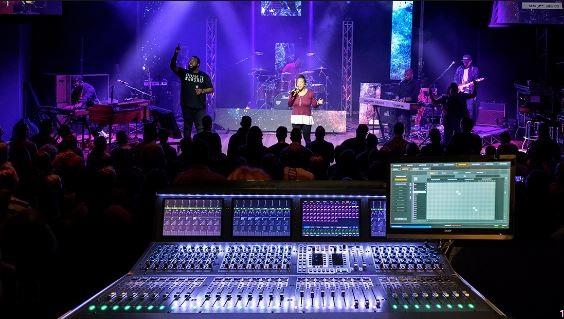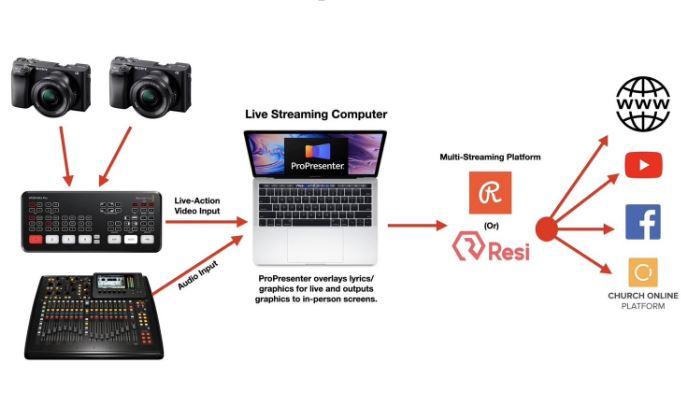The digital age has transformed the way we connect, communicate, and experience spirituality. Picture this: a vibrant congregation gathered in a resplendent church, their voices soaring in harmony, their hearts united in faith. The sun’s rays gently filter through the stained glass windows, casting a kaleidoscope of colors on the faces of the worshippers. But there’s something more than tradition at play here; it’s the powerful hum of media system technology seamlessly integrated into the sacred space.
Imagine settling into the pew at your church, ready for a spirit-filled Sunday service. The pastor takes the stage, opens his mouth to deliver a soul-stirring message, and… SQUAWK! A cacophony of feedback erupts from the speakers, turning the holy moment into a soundcheck gone wrong.
Now, this wasn’t always the case at my church. Back in the day, our media setup was about as reliable as a flip phone’s battery life. Crackly mics, flickering projectors, and software that would crash faster than a teenager’s internet connection on finals week – it was a recipe for more frustration than faith-building.
But then, something changed. We, the church tech team decided it was time for a media ministry makeover. Implementing these changes required significant effort. We weren’t exactly tech wizards – more like enthusiastic amateurs with a healthy dose of YouTube tutorials. But here’s the thing: with a little planning, some elbow grease, and a whole lot of trial and error, we transformed that tech nightmare into a ministry powerhouse.
And guess what? You can too! Whether your church has a media team of seasoned professionals or a bunch of well-meaning volunteers like us, This article provides a step-by-step approach to creating a media system that enhances your worship experience, not disrupts it.
Finding Your Frequency
In this article, we explore how the marriage of faith and technology can create a harmonious symphony, resonating with the souls of the faithful, and opening doors to a world of possibilities within the hallowed walls.
But, before we dive into the nitty-gritty, let’s remember, this ain’t about fancy gadgets. It’s about connecting with people, spreading the message, and creating a worship experience that moves hearts. So, keep it real, keep it relevant, and let’s get started!
Identifying the critical components that are essential for the core functionality of the media system of a church or an organization
The critical components that are essential for the core functionality of the media system for a church include:
- Audio/video equipment: This includes cameras, microphones, mixers, audio/video recorders, and playback devices.
- Lighting equipment: This includes stage lights, house lights, and spotlights.
- Electronics/Computer equipment: This includes computers, laptops, tablets, and smartphones.
- Software: This includes video editing software, live streaming software, and presentation software.
- Networking: This includes a network infrastructure that connects all of the equipment together.
- People: This includes a team of volunteers or staff members who are trained to operate the equipment and software.
In addition to these essential components, church media systems may also include other features such as:
- Projection screens: These can be used to display videos, lyrics, and other presentations during worship services and other events.
- Digital signage: This can be used to display announcements, news, and other information to church members and visitors.
- Live streaming: This allows church services and other events to be streamed live over the internet so that people can watch them from anywhere in the world.
- Video editing: This allows church media teams to create and edit videos for use in worship services, on social media, and on the church website.
The specific components of a church media system will vary depending on the size and budget of the church, as well as the specific needs of the church’s ministry. However, all church media systems should include the essential components listed above in order to function effectively.
Lighting Up the Service
Now, let’s talk about visuals. Here’s what you’ll need:
- Projector: A good quality projector is key to displaying lyrics, announcements, and other visual elements. Make sure it’s bright enough for the size of your space.
- Projection Screen: This is where the magic happens – choose a screen that provides a clear, crisp image.
- Presentation Software: There are plenty of user-friendly presentation software options like PowerPoint or Google Slides. Use them to create engaging visuals that complement your service.
Simple Church Projection/Presentation Setup
People come to hear the word, and if they can’t hear it clearly, well, that’s a problem. Invest in decent microphones (wireless if possible, for that preacher with the moves!), a solid mixer, and speakers that cover the whole space evenly. Good acoustics matter too! Talk to someone who knows about dampening echoes and making your church sound like a heavenly concert hall.

Here are some of the key benefits of a well-equipped media system
Enhanced Worship Experience: A media system can provide high-quality audio and visual elements, such as clear sound, large screens, and projectors, to amplify the worship experience. This helps members connect with the message and music on a deeper level. It can also be used to broadcast announcements, upcoming events, and important information to the congregation, ensuring everyone is well-informed.
Visual aids, videos, and graphics can complement sermons, making complex topics easier to understand and remember.
Visuals are powerful, but don’t go overboard. Projectors and screens are great for displaying lyrics, announcements, and even the occasional inspirational video. But remember, you’re not hosting a rave. Keep the lighting subtle, focused, and don’t blind your congregation with flashing colors. It’s about enhancing the message, not distracting from it.
Accessibility and Inclusivity:
Media systems can include features like closed captioning and hearing loop systems, making services more accessible to those with hearing impairments. Live translation services can help non-English speakers follow the service.
Interactive Features: Some media systems enable congregation members to interact during services through polls, comments, or Q&A sessions.
Livestreaming: Broadcasting services online allows members who cannot attend in person to participate remotely, strengthening the sense of community.
Other Benefits Include:
- Bible Study and Educational Materials: Media systems can display Bible verses, references, and study materials, enriching the educational aspect of worship.
- Guest Speakers and Workshops: The system can support the hosting of guest speakers, workshops, and conferences, providing valuable learning opportunities for the congregation.
- Concerts and Performances: A well-equipped media system can host musical performances, concerts, and other events, expanding the church’s outreach and cultural offerings.
- The system can accommodate special ceremonies and events within the church community.
- Recording Services: Media systems can record services and events for archival purposes, enabling members to revisit or catch up on missed services.
- Documentation of Milestones: Capture and commemorate important moments, such as baptisms, confirmations, and special sermons.
- Online Giving: Integrate online donation platforms into the media system to facilitate easy giving during services and fundraisers.
- Online Presence: Use the media system to maintain a strong online presence through social media integration and live streaming, reaching a broader audience.
- Safety and Security: In times of emergencies or crises, the media system can be used to relay important safety instructions and information to ensure the congregation’s well-being.
Identifying the specific requirements of the church
Identifying the specific requirements of a church when setting up a media system is crucial to ensure that the system aligns with the unique needs and goals of the congregation.
Start by engaging with church leadership, clergy, and key stakeholders to understand their vision and goals for the media system. What are their primary objectives in implementing this technology? Establish a clear budget for the media system project. Determine and discuss with the leadership how much the church is willing to invest in equipment, installation, maintenance, and future upgrades.
Understand the church’s worship style and the role media will play in enhancing it. Will you be incorporating contemporary music, traditional hymns, or a blend of both? What type of content will be displayed, such as song lyrics, scripture verses, or multimedia presentations?
Discuss whether there is a need to record and archive services and events for later viewing or reference. This may require additional recording equipment and storage solutions.
Here are some additional tips for building a church media system:
- Start with a clear vision for what you want your media system to accomplish. What are your goals for using media in your ministry? Once you have a clear vision, you can start to develop a plan for acquiring the necessary equipment and resources.
- Be realistic about your budget. Church media systems can be expensive, but there are ways to build a system on a budget. Start with the essential components and add on other features as you can afford to.
- Train your volunteers and staff. It’s important to have a team of people who are trained to operate your media system effectively. This will help to ensure that your services and events run smoothly.
- Be creative! There are many different ways to use media in your ministry. Don’t be afraid to experiment and find new ways to engage your congregation and reach out to the community.
Adaptability: A well-designed media system can be flexible and adaptable, allowing the church to evolve with changing technological trends and communication needs.
Tech Ain’t Everything
Remember, technology is a tool, not a savior. The real magic happens when people come together, share their stories, and lift each other up. Use your media system to create opportunities for connection, collaboration, and community building. That’s where the true power lies.
So, there you have it, my friend! With a little planning, some creativity, and a whole lot of passion, you can build a media system that elevates your church experience and spreads the word far and wide. Now go forth, shine your light, and make your community proud!

Pingback: How to use a mini HDMI Cable to Connect Your Devices - TechVoltMedia
Pingback: Capturing Motion: Comparison of Vicon and Rokoko Motion Capture Technology - TechVoltMedia